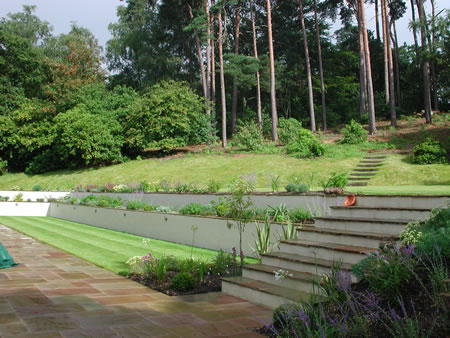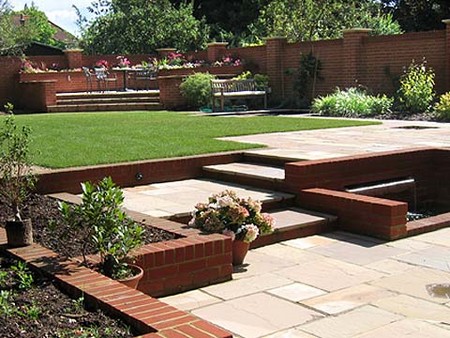Many older houses have a garden that is accessed from a basement later re-modelled in order to allow more light into the kitchen or dining area. This garden is designed on two levels to cope with such an arrangement. The levels are asymmetrical and joined by steps, the shape of which echoes the curved retaining wall of a raised bed.
The garden is overlooked from two sides and is also below street level and very shaded. The clever design raises the main area of the garden towards the light, while still offering shelter and seclusion. The plants themselves link both parts of the garden, as does the use of the same bricks, but attention is focused on the upper, roomy level and the vibrant, rich planting.
The lower area of this garden is too small to be used for seating and is in constant shade, so very few plants will thrive there. However, plants from the upper levels are encouraged to cascade down, providing colour and interest as well as improving the view from the window. The eye is drawn to the upper level by the clever use of the furniture, water basin and plants.
Features
This is a square plot and because it is surrounded by high walls it has the potential to be dull and boring, especially as the lower level is shaded and very small. The asymmetrical design minimizes the square feel and introduces different depths for variety and interest. The dominating end wall has been lightened with a colour wash and cloaked with lots of climbing plants. White trellis, with curved, attractive shapes along the top, further softens the wall and provides a framework for the shade-tolerant climbers. It encourages the eye to travel upwards to space and light. The water basin is an eyecatching feature, which draws the eye to the far corner, where it nestles among long-flowering plants, such as campanula and roses.
Raised beds bring the plants nearer the light and gently lift the eye-line, reducing the impact of the difference in levels. The shapes of the beds are not, in this garden, totally disguised by plants because allowing their shape and lines to be seen detracts from the strong, square shape of the plot and draws attention to the curving, unusual lines of the beds, making the garden much more interesting.
Uniformity and continuity ate provided by using the same bricks for both areas, but arranging them in a different pattern emphasizes the different character of the two areas. The walls of the raised beds are built of the same bricks to unite the entire garden.
The seating area is surrounded entirely by greenery, creating a secluded haven to relax and entertain in. Here, the harsh edges of the brickwork are softened by trailing plants that spill out on to the floor, bringing the plants into every part of the area and subtly dividing it from the rest of the garden. The furniture is white to complement the trellis, and the white walls of the house, together with the trellis and furniture, reflect sunlight and lighten the feel to this garden, which could otherwise be shady and dull.
The eye is drawn to the upper level by the central bed and steps, then on to the plants and asymmetrical beds of the upper level and then higher still to the trellis and plants there, so creating a sense of space and an attractive, sheltered garden.
In the lower area a single container is used to disguise the hard angle where the two walls join.
Planting
Largely in shades of pink and red, the plants have been carefully selected to reinforce the strong design. The central raised bed is packed with colourful flowering shrubs and trailing plants to link the two areas, and this is an excellent way of getting colour into the lower area without constructing more beds or using containers that will take up space.
Tropaeolum tricolor (nasturtium) is grown up the wall to bring the planting closer to the house and complete the transformation into another room, an extension of the living area.
Hanging baskets filled with seasonal and evergreen plants add depth to the trellis and further break up the wall. Using baskets of different sizes broadens the range of plants you can grow and makes it possible for those that need to be in full sun to be placed in the appropriate positions.
Categories
Advertisements
Recent Articles
 How to Understand Bed Sizes – A Small Guide
How to Understand Bed Sizes – A Small Guide How to Select Some Must Have Kitchen Accessories
How to Select Some Must Have Kitchen Accessories Best Way to Change a Car Tire
Best Way to Change a Car Tire Best Way to Write an Affirmation
Best Way to Write an Affirmation Best Way to Take Charge of Your Financial Life
Best Way to Take Charge of Your Financial Life Best Way to Survive a Party When You Don’t Know Anyone
Best Way to Survive a Party When You Don’t Know Anyone Best Way to Stop Self Sabotaging Yourself
Best Way to Stop Self Sabotaging Yourself Best Way to Start Journal Writing
Best Way to Start Journal Writing Best Way to Speak with a Powerful Voice
Best Way to Speak with a Powerful Voice Best Way to Simplify Your Life
Best Way to Simplify Your Life Best Way to Respond to a Put-Down
Best Way to Respond to a Put-Down Best Way to Reduce Acne Breakouts
Best Way to Reduce Acne Breakouts Best Way to Recover from Dining Disasters
Best Way to Recover from Dining Disasters Best Way to Quit Your Job Gracefully
Best Way to Quit Your Job Gracefully Best Way to Make Your Own Website
Best Way to Make Your Own Website



Leave a Reply